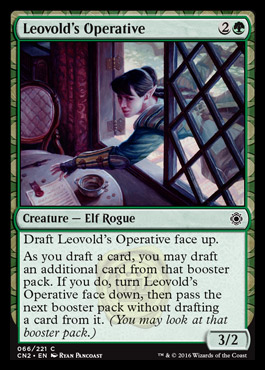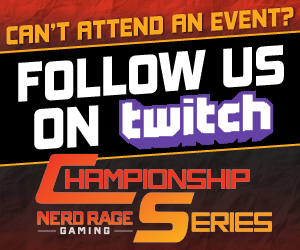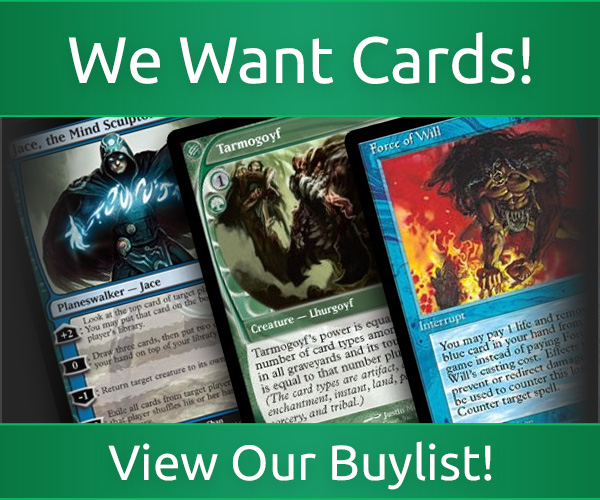Max Kahn: Everything You Need to Know About Conspiracy: Take the Crown
Hey there, and welcome to Everything You Need to Know About Conspiracy: Take the Crown. In this article, I’ll be addressing each of the new and returning abilities in the latest Conspiracy set, I’ll talk about how I personally run Conspiracy drafts, and we’ll talk about some cool card interactions within the set. Let’s dive in!
Conspiracy drafting is a completely different animal from other draft formats, and I learned a lot about running these events when the last Conspiracy was released. Here are some tips and tricks to make your Conspiracy drafting experience as easy as possible:
- Time the draft. I know what you’re thinking: “I thought timed drafts were only supposed to be at Pro Tours and Grand Prix!” You’d be right. However, the reason that I personally like to time Conspiracy drafts is to make sure that everybody is on the same pack at the same time. In the first couple of untimed drafts that I ran during the first Conspiracy release, people would be drafting their final card of the pack when some people had four cards remaining. This would make cards like Whispergear Sneak and Lurking Automaton a little confusing, as they would interrupt the flow of the draft. By timing the draft, say 1:30 for the first pick, and then subtracting 5 seconds for each subsequent pick, each person is drafting each card of the pack at the same time, which is important for some of the new “draft matters” effects.
- Have a specified time in between picks for any “Conspiracy effects”. Along with timing the draft rounds, giving time between picks in order to perform draft effects was critical to keep the draft organized. After each player had picked their card from the pack, I would wait about five to ten seconds for people to follow some of the instructions on their drafted cards. This time could be spent for noting certain aspects of a drafted card, deciding whether to remove cards from your draft pool, or drafting additional cards from that booster.
- Have sticky notes and pens accessible to players during the draft portion. Being able to quickly scribble down a card name and stick it onto the card in your draft pool is much easier than writing everything down on a separate piece of paper and then trying to remember which card names were written down for each effect.
Now that we’ve talked about some tips to make your drafting experience as easy as possible, let’s review the returning and new mechanics to make your playing experience as easy as possible.
Basic Landcycling:  Basic Landcycling is a variant on cycling, and has been a popular go-to mana fixing solution for sets such as Modern Masters, Duel Decks, and Planechase since its release in Conflux. The premise of basic landcycling is simple. Pay the mana cost (usually one generic mana and one mana of the color of the spell) and discard the card with basic landcycling. Then, search your library for any basic land, reveal it, and put it into your hand. Then shuffle your library. Basic landcycling is an activated ability (notably not considered casting a spell), so you wouldn’t be able to Negate somebody’s basic landcycle.
Basic Landcycling is a variant on cycling, and has been a popular go-to mana fixing solution for sets such as Modern Masters, Duel Decks, and Planechase since its release in Conflux. The premise of basic landcycling is simple. Pay the mana cost (usually one generic mana and one mana of the color of the spell) and discard the card with basic landcycling. Then, search your library for any basic land, reveal it, and put it into your hand. Then shuffle your library. Basic landcycling is an activated ability (notably not considered casting a spell), so you wouldn’t be able to Negate somebody’s basic landcycle.
Hidden Agenda: Hidden Agenda is an ability found on some Conspiracy cards. Before the game begins, for each Conspiracy with hidden agenda, you can secretly choose a card name. In order to do this, I’d probably write my card name on a sticky note and post it directly on the Conspiracy. Conspiracies with Hidden Agenda start the game face-down in the Command Zone, and you can choose to turn them face up any time you have priority. Immediately when they are turned face up, their effect becomes “live.” For example, let’s say you are attacking with a creature that you named for Hired Heist’s Hidden Agenda. After your opponent declares no blocks, you could choose to turn Hired Heist face-up in the command zone. Turning a Conspiracy with Hidden Agenda face up is a special action (like morph or playing a land), so it cannot be responded to. Any card in Magic is legal to be named, but Soldier (the name of a token) isn’t legal to be named, since there is no card named Soldier.
Hidden Agenda is an ability found on some Conspiracy cards. Before the game begins, for each Conspiracy with hidden agenda, you can secretly choose a card name. In order to do this, I’d probably write my card name on a sticky note and post it directly on the Conspiracy. Conspiracies with Hidden Agenda start the game face-down in the Command Zone, and you can choose to turn them face up any time you have priority. Immediately when they are turned face up, their effect becomes “live.” For example, let’s say you are attacking with a creature that you named for Hired Heist’s Hidden Agenda. After your opponent declares no blocks, you could choose to turn Hired Heist face-up in the command zone. Turning a Conspiracy with Hidden Agenda face up is a special action (like morph or playing a land), so it cannot be responded to. Any card in Magic is legal to be named, but Soldier (the name of a token) isn’t legal to be named, since there is no card named Soldier.
Monstrosity: Originally hailing from Theros and Journey into Nyx, Monstrosity is an ability that, quite literally, makes your creature monstrous. Each creature with monstrous features a cost to make the creature monstrous and a monstrosity number, denoted by a number after the word “Monstrosity.” Any time you have priority, you can pay the cost in order to activate the Monstrosity ability. When the ability resolves, if the creature isn’t already monstrous, the creature becomes monstrous and you put a number of +1/+1 counters on the creature equal to the number following the word “Monstrosity.” Once a creature is monstrous, there is no way for it to lose its monstrous status unless it leaves the battlefield.
Originally hailing from Theros and Journey into Nyx, Monstrosity is an ability that, quite literally, makes your creature monstrous. Each creature with monstrous features a cost to make the creature monstrous and a monstrosity number, denoted by a number after the word “Monstrosity.” Any time you have priority, you can pay the cost in order to activate the Monstrosity ability. When the ability resolves, if the creature isn’t already monstrous, the creature becomes monstrous and you put a number of +1/+1 counters on the creature equal to the number following the word “Monstrosity.” Once a creature is monstrous, there is no way for it to lose its monstrous status unless it leaves the battlefield.
Some abilities trigger when the creature becomes Monstrous. In that case, the trigger will go onto the stack after the Monstrosity ability completely finishes resolving.
New Mechanics
Council’s Dilemma:  Council’s Dilemma works very similarly to Will of the Council from the last Conspiracy expansion. The notable expansion is that instead of simple majority rules voting, the effect on Council’s Dilemma scales for each vote. When any triggered ability or spell with Council’s Dilemma resolves, starting with you, each player votes for one of the two choices on the card. Importantly, this means that nobody will know the outcome of the vote when deciding to respond to the spell being cast. Each vote is made in turn order, and nobody can abstain from the voting. Then, the votes are tallied and the instructions are followed on the card. For example, if Capital Punishment resolved and three players voted for Death and one player voted for Taxes, each opponent would sacrifice three creatures and discard one card.
Council’s Dilemma works very similarly to Will of the Council from the last Conspiracy expansion. The notable expansion is that instead of simple majority rules voting, the effect on Council’s Dilemma scales for each vote. When any triggered ability or spell with Council’s Dilemma resolves, starting with you, each player votes for one of the two choices on the card. Importantly, this means that nobody will know the outcome of the vote when deciding to respond to the spell being cast. Each vote is made in turn order, and nobody can abstain from the voting. Then, the votes are tallied and the instructions are followed on the card. For example, if Capital Punishment resolved and three players voted for Death and one player voted for Taxes, each opponent would sacrifice three creatures and discard one card.
Double Agenda:  Double Agenda functions identically to Hidden Agenda (read above), except that you name two different cards except for one. Your opponent will not know if your face down Conspiracy cards are Hidden Agenda or Double Agenda until they are turned face up.
Double Agenda functions identically to Hidden Agenda (read above), except that you name two different cards except for one. Your opponent will not know if your face down Conspiracy cards are Hidden Agenda or Double Agenda until they are turned face up.
Goad:  Goading a creature is an action that sets up two requirements that must be followed on the goaded creature’s next combat step. First, any goaded creature must attack if able. Second, the goaded creature must attack a player other than the player who goaded that creature if able. This means that if you goad your opponent’s creature, and you’re the only two players left in the game, the goaded creature must attack you. If, in a 4-player game, Player A and Player B both goad Player C’s creature, Player C’s creature must attack if able and must attack Player D.
Goading a creature is an action that sets up two requirements that must be followed on the goaded creature’s next combat step. First, any goaded creature must attack if able. Second, the goaded creature must attack a player other than the player who goaded that creature if able. This means that if you goad your opponent’s creature, and you’re the only two players left in the game, the goaded creature must attack you. If, in a 4-player game, Player A and Player B both goad Player C’s creature, Player C’s creature must attack if able and must attack Player D.
Melee: Melee is a new combat ability that will give your creatures +1/+1 until end of turn for each opponent you attacked this combat. That means that if you attack your opponent with just one creature with melee, it will get +1/+1 until end of turn, since you attacked only one opponent. But if you control three creatures, and have each one attack a different opponent, each creature with melee you control will get +3/+3 until end of turn. If you attack a planeswalker, melee will still trigger, but will not count the defending Planeswalker as another opponent you attacked this combat.
Melee is a new combat ability that will give your creatures +1/+1 until end of turn for each opponent you attacked this combat. That means that if you attack your opponent with just one creature with melee, it will get +1/+1 until end of turn, since you attacked only one opponent. But if you control three creatures, and have each one attack a different opponent, each creature with melee you control will get +3/+3 until end of turn. If you attack a planeswalker, melee will still trigger, but will not count the defending Planeswalker as another opponent you attacked this combat.
Monarch: The game starts with no monarch. There are three ways to become the monarch. The first is to play a card like Palace Sentinels, which immediately makes you the monarch. The second way is to deal combat damage to the player who currently is the monarch. If you do, you become the monarch. The final way can only happen if the monarch loses the game. If the monarch loses the game on your turn, you become the monarch. If the monarch loses the game on their own turn, the next player in turn order becomes the monarch. Once the monarchy has been introduced to the game, there will be only one monarch at a time for the rest of the game, and there is no way for the monarchy to disappear. Being the monarch has two benefits. The first is that at the beginning of the monarch’s end step, they get to draw a card. Secondly, there are cards in the set that give you additional benefits if you are the monarch.
The game starts with no monarch. There are three ways to become the monarch. The first is to play a card like Palace Sentinels, which immediately makes you the monarch. The second way is to deal combat damage to the player who currently is the monarch. If you do, you become the monarch. The final way can only happen if the monarch loses the game. If the monarch loses the game on your turn, you become the monarch. If the monarch loses the game on their own turn, the next player in turn order becomes the monarch. Once the monarchy has been introduced to the game, there will be only one monarch at a time for the rest of the game, and there is no way for the monarchy to disappear. Being the monarch has two benefits. The first is that at the beginning of the monarch’s end step, they get to draw a card. Secondly, there are cards in the set that give you additional benefits if you are the monarch.
Card by Card Notes:
Avatar of Woe’s cost reduction effect counts the number of creature cards in all graveyards, not just yours.
Burgeoning will only trigger when an opponent plays a land. It will not trigger when a land enters the battlefield from effects such as Explosive Vegetation.
Daretti, Ingenious Iconoclast‘s -1 ability requires you to choose a target artifact or creature when the ability is activated. You do not have to sacrifice an artifact until the ability resolves, and your opponent will not have the opportunity respond in between you sacrificing the artifact and destroying the target artifact or creature.
No matter who activates the abilities to put Plot counters onto Deadly Designs, the controller of Deadly Designs chooses which creatures to target.
When Kaya, Ghost Assassin enters the battlefield on your upkeep after her (0) ability was previously activated, her loyalty counters will reset to 5.
The attacking creature you target with Kill Shot doesn’t need to be attacking you.
If you or a creature you control becomes the target of a spell or ability an opponent controls while you have Leovold, Emissary of Trest on the battlefield, you draw a card before the spell or ability that targets you resolves. This means that if an opponent attempts to Lightning Bolt your creature, you can draw a counterspell off of Leovold’s triggered ability in time to counter the Lightning Bolt.
Recruiter of the Guard checks the power and toughness printed on the card. For example, if you have three creatures in your graveyard, you could still find Liliana’s Elite with Recruiter of the Guard. You can also always find cards like Hangarback Walker. For cards such as Tarmogoyf, the ability that sets the power and toughness applies in all zones, so Tarmogoyf would need to be an 0/1 or a 1/2 based on card types in current graveyards if you’d like to find it with Recruiter of the Guard.
Once Sanctum Prelate resolves, you do not have the opportunity to respond to choosing a number. This functions similarly to Iona, Shield of Emeria.
If a creature enters the battlefield while you control Selvala, Heart of the Wilds, you have the opportunity to respond to the triggered ability by making your creature larger with a Giant Growth effect in order to draw a card. This is because Selvala, Heart of the Wilds‘s trigger checks to see if the creature has the greatest power among creatures on the battlefield only when the ability resolves, since it isn’t written with an “intervening if” clause. (See more on “intervening if” clauses in my last article.)
All cards with Show and Tell are put onto the battlefield simultaneously. Nobody knows which cards will be put onto the battlefield before anyone else does. I would suggest everybody puts their card onto the battlefield face-down, and then everyone reveals those cards simultaneously.
If X is 8 or more for Subterranean Tremors, the 8/8 red Lizard token will be created after the spell has dealt 8 damage to each creature.
Wild Pair checks the creature’s power and toughness in the library the same way that Recruiter of the Guard does.
That’s all I’ve got for Everything You Need to Know about Conspiracy: Take the Crown. Feel free to comment below or reach out to me on social media at @MaxPlaysMTG if you have any questions about card interactions (yes, there is an infinite combo you can pull off in this set) or running Conspiracy drafts at your local game store. I’ll be judging at GP Indy this weekend, so feel free to say hi! Until next time!
Max Kahn is a Level 2 judge from Buffalo Grove, Ill. who serves as the head judge for the Nerd Rage Championship Series.






